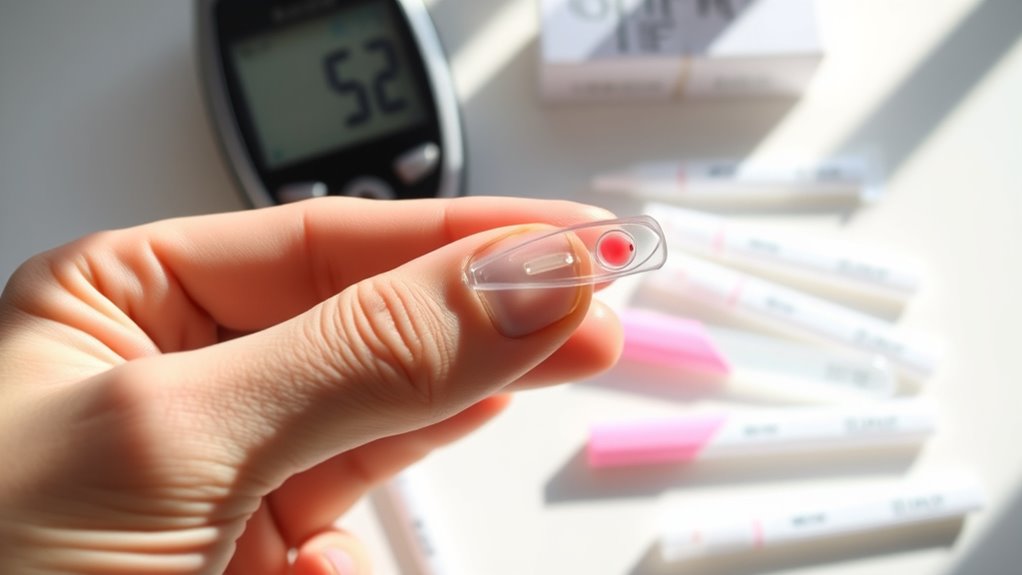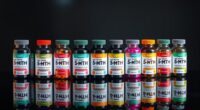To get accurate results from DIY blood tests, choose trusted kits suited to your health goals and follow the instructions carefully, including proper handwashing and sample collection techniques. Handle samples gently, label them accurately, and store them correctly before shipping. Remember, DIY tests have limits and can’t replace professional advice; abnormal results warrant consulting a healthcare provider. Keep your data secure and private—continue exploring to learn how to maximize your test’s accuracy and safety.
Key Takeaways
- Choose reputable, certified testing kits aligned with specific health goals to ensure accuracy and meaningful results.
- Follow strict sample collection protocols: proper hygiene, correct technique, labeling, and storage to maintain sample integrity.
- Record results accurately, including units and reference ranges, and store data securely with encryption and access controls.
- Be aware of DIY test limitations: false positives, limited scope, and the need for professional interpretation for accurate health assessment.
- Protect data privacy by using secure platforms, strong authentication, encryption, and regular security updates to prevent breaches.
Understanding the Purpose of Your Test
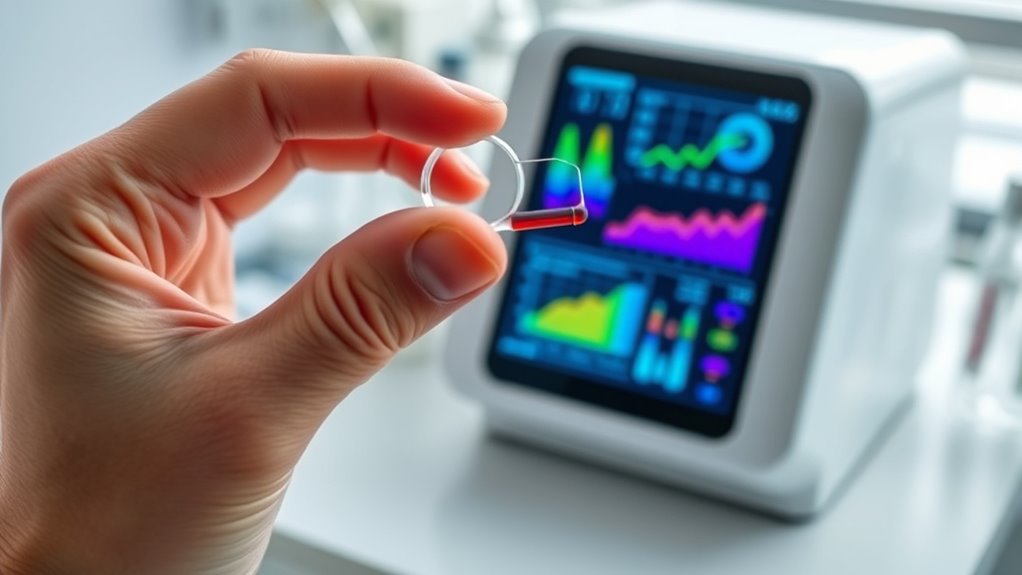
Understanding the purpose of your blood test helps you make informed decisions about your health. Knowing why you’re testing guides you in interpreting the results accurately within the right health context. For example, a blood sugar test can detect early signs of diabetes, while a cholesterol test assesses your cardiovascular risk. When considering DIY blood tests, it’s crucial to understand what the test measures and its intended use. Test accuracy varies depending on the method and device, so understanding the health context helps you evaluate whether the results are reliable enough for decision-making. Being clear about your health goals ensures you choose the right test and interpret the findings correctly, empowering you to take appropriate steps for your well-being. Additionally, understanding floating on water can influence how you interpret your subconscious signals, underscoring the importance of context in all personal assessments. Recognizing the accuracy of testing methods helps you gauge the reliability of your results and decide when to seek professional advice.
Choosing the Right DIY Testing Kit
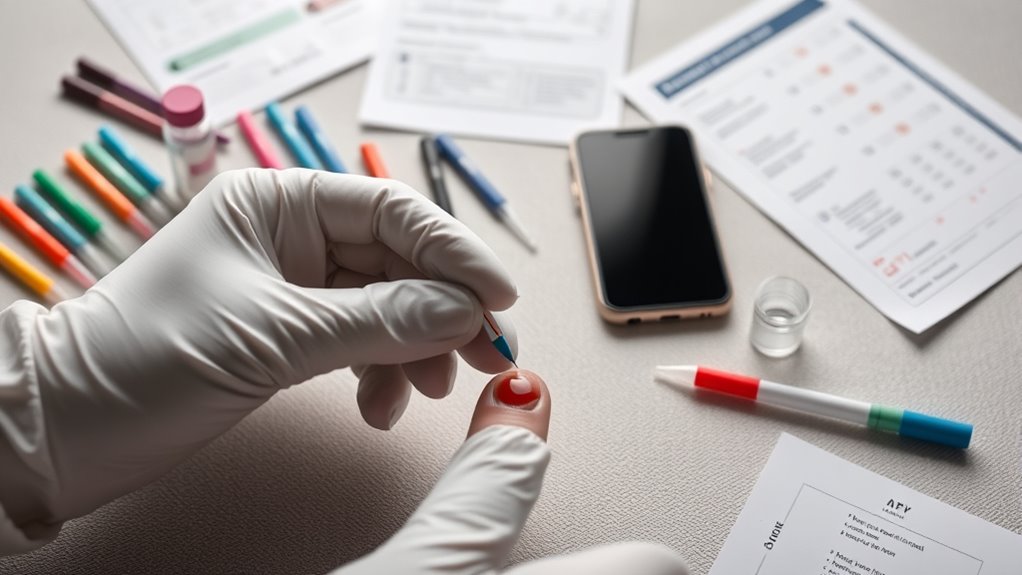
Choosing the right DIY testing kit starts with matching the device to your specific health goals and the type of information you need. Focus on blood test accuracy, as reliable results depend on high-quality kits. When selecting a kit, consider factors like the type of markers it measures and its reputation for precision. Kit selection tips include checking reviews, verifying certifications, and ensuring the instructions are clear and user-friendly. Keep in mind that not all kits are created equal—some may offer more detailed insights or better accuracy. Matching your needs with a trusted, well-reviewed device helps ensure you get meaningful, reliable results. Additionally, understanding blood health markers is essential for interpreting your test results correctly. Being aware of test reliability and the potential for variability can help you make informed decisions based on your results. Remember, a carefully chosen kit can make all the difference in accurately monitoring your health at home. Additionally, understanding bank SWIFT/BIC codes is essential if you need to make secure payments for premium testing kits or health services online.
Preparing for Sample Collection
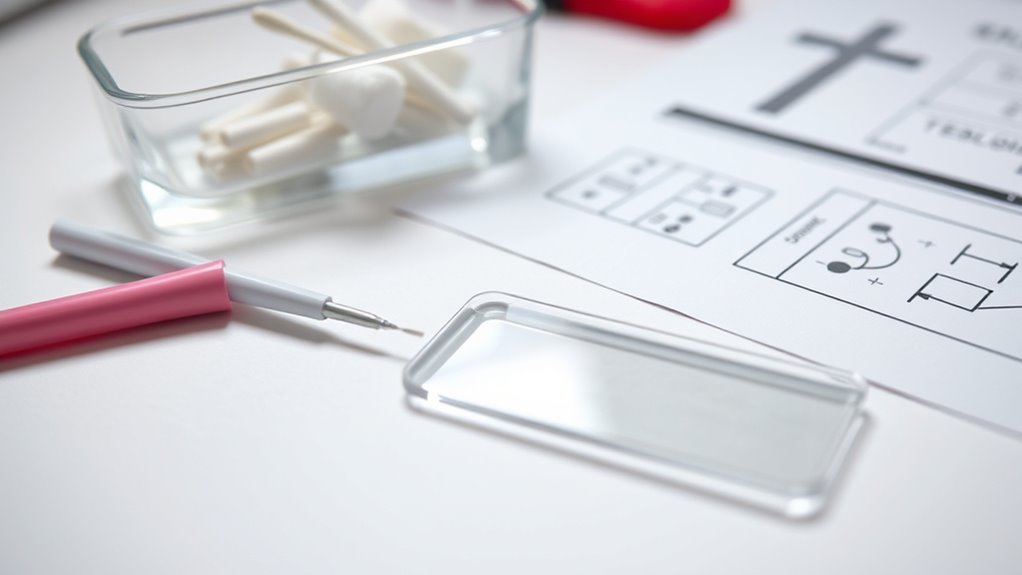
To guarantee accurate results, preparing properly before collecting your blood sample is essential. Start by washing your hands thoroughly with soap and warm water to ensure cleanliness and reduce contamination risks. Gather all needed supplies, including alcohol wipes, sterile lancets, and collection containers, to streamline the process. Confirm your workspace is clean and well-lit, avoiding distractions. Follow the kit instructions carefully, paying attention to any specific preparation steps like fasting or avoiding certain medications. Proper sample handling is crucial—label your sample immediately and keep it at the recommended temperature. Avoid touching the collection area after sterilizing it, and handle the sample gently to prevent hemolysis or contamination. Good preparation minimizes errors and guarantees more reliable results. Additionally, being aware of proper storage techniques can help maintain sample integrity during transport or processing. Understanding sample collection procedures can further improve the accuracy of your test results. Using the correct technique also reduces the risk of contamination, ensuring more trustworthy outcomes.
Proper Techniques for Blood Sample Collection
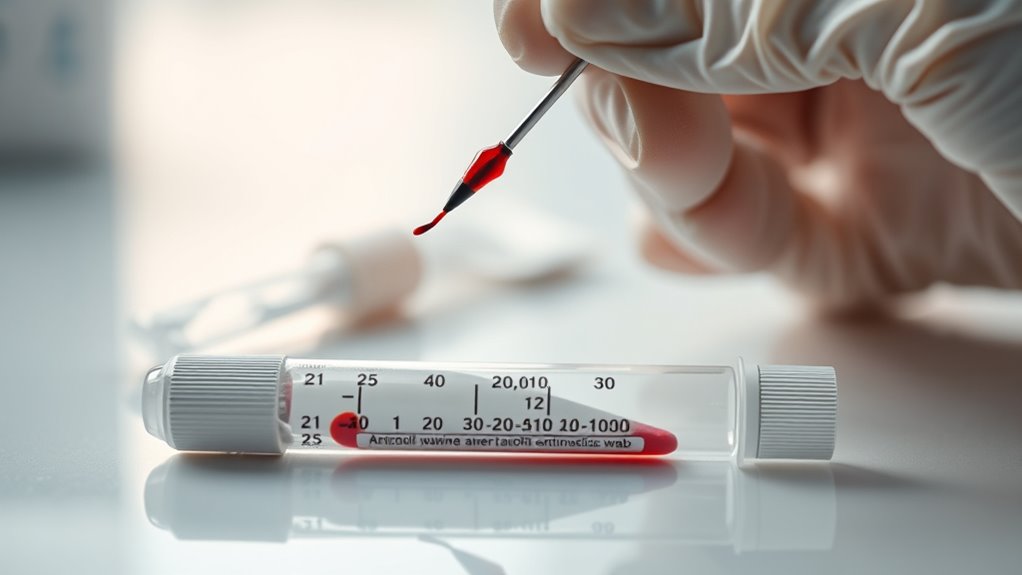
When collecting a blood sample, using proper techniques is essential to guarantee the sample is accurate and uncontaminated. Begin by selecting the appropriate method—capillary or venous. Capillary collection involves pricking your finger and collecting blood for a blood smear or small tests, so make certain the finger is warmed and cleaned. For venous samples, use a sterile needle and tube, keeping the area disinfected. When preparing a blood smear, make sure to spread the blood evenly on the slide to avoid artifacts. Handle samples gently to prevent hemolysis or contamination. Understanding the difference between capillary and venous blood helps interpret results correctly. Proper technique ensures reliable test outcomes and minimizes errors during collection. Additionally, being aware of the sample collection techniques used can influence the accuracy of the results obtained. Following proper handling procedures can also help prevent sample degradation and preserve integrity, further enhancing test reliability. Incorporating quality control measures can further enhance the reliability of blood test results.
Ensuring Sample Integrity During Handling and Shipping
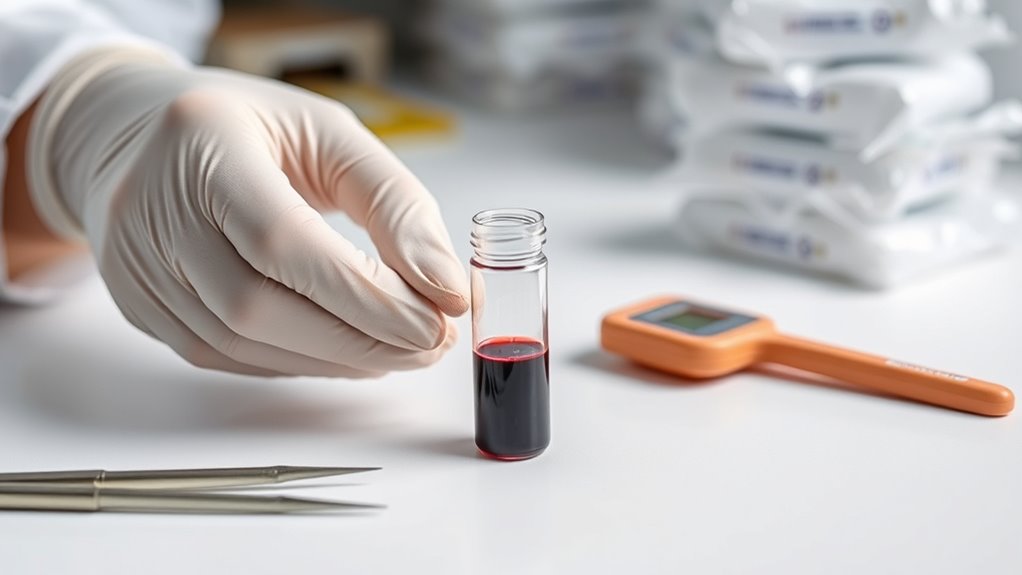
Maintaining sample integrity during handling and shipping is essential to guarantee accurate test results. To prevent sample contamination, always ensure your sample is properly sealed and labeled. Use the recommended packaging requirements, such as leak-proof containers and protective cushioning, to safeguard against damage and spills. Avoid opening or tampering with the sample once collected; mishandling can introduce contaminants that compromise results. When preparing for shipment, double-check that all packaging components are secure and compliant with postal or courier guidelines. Keep samples at the appropriate temperature, if specified, to prevent degradation. Proper handling and packaging minimize the risk of contamination and sample deterioration, ensuring your blood test results remain reliable and valid upon arrival at the lab. Additionally, understanding digital literacy is crucial for managing your samples effectively in an increasingly digital healthcare environment. Developing handling protocols can further ensure consistency and safety during sample transport. Being familiar with home decor concepts such as organized storage spaces can also help in planning your sample packaging and transportation efficiently.
Reading and Recording Your Results Accurately
Reading and recording your results accurately is vital to understanding your health status and guaranteeing reliable data. Begin by carefully reviewing your test results, making sure to interpret the measurements correctly. Proper sample labeling is essential; double-check that each sample label matches the corresponding test and date. When documenting your results, write down the exact values, noting units of measurement and reference ranges if provided. Use a dedicated logbook or digital app to track your results over time, which helps identify trends. Avoid abbreviations or unclear notes that could cause confusion later. Accurate result documentation ensures you can easily compare past and current readings and share reliable data with healthcare professionals if needed. Precision in reading and recording supports better health insights and decision-making. Additionally, understanding AI in education can help develop tools that assist in tracking and interpreting health data more effectively. Developing standardized protocols for sample collection and testing can further improve the accuracy and reliability of your results.
Recognizing the Limitations of DIY Blood Tests
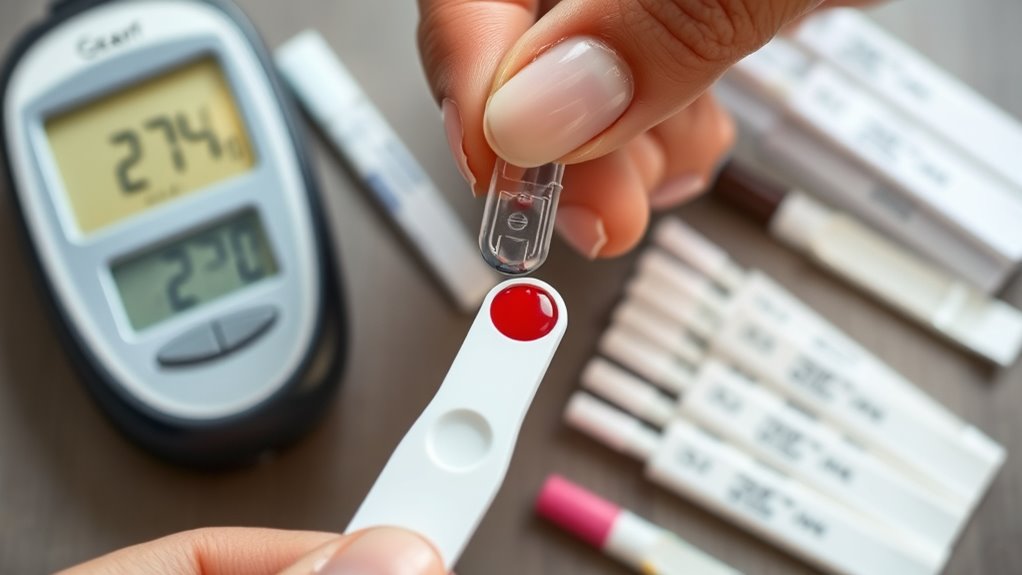
While DIY blood tests can be convenient and cost-effective, it’s important to understand their limitations. False positives can lead you to believe you have a condition when you don’t, causing unnecessary worry. Test variability means results may differ between tests due to factors like sample collection or device accuracy. Recognizing these issues helps you avoid misinterpretation and overreaction. Here’s a quick comparison:
| Limitation | Explanation |
|---|---|
| False positives | Incorrectly indicating a problem exists |
| Test variability | Results may differ between tests or brands |
| Limited scope | Only screens for specific markers, not diagnosis |
| No professional input | Cannot replace expert medical advice |
Knowing these limitations ensures you interpret DIY blood test results with caution and avoid unnecessary stress.
Knowing When to Consult Healthcare Professionals
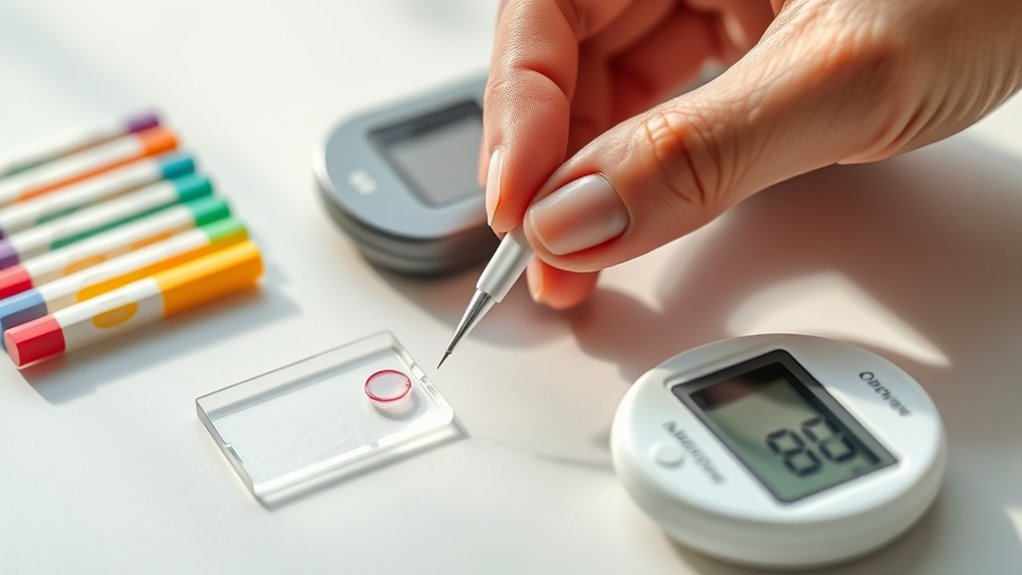
DIY blood tests can be helpful for monitoring specific health markers at home, but they’re not a substitute for professional medical advice. If you experience medical emergencies or urgent symptoms, seek immediate care instead of relying solely on home test results. Signs like severe pain, difficulty breathing, sudden weakness, or sudden vision changes require prompt attention from healthcare professionals. Don’t wait to interpret your results if they indicate abnormal values; instead, consult your doctor to understand what it means and determine next steps. Remember, DIY tests are useful tools but cannot replace exhaustive medical evaluations. Trust your instincts—if something feels wrong or alarming, prioritize professional consultation to ensure your safety and proper treatment. Additionally, understanding the holistic approach to health can help you make more informed decisions about your well-being. Being aware of medical guidelines can also assist you in recognizing when professional advice is necessary. Recognizing the limitations of DIY testing is crucial to avoid misinterpretation and unnecessary anxiety.
Maintaining Privacy and Data Security
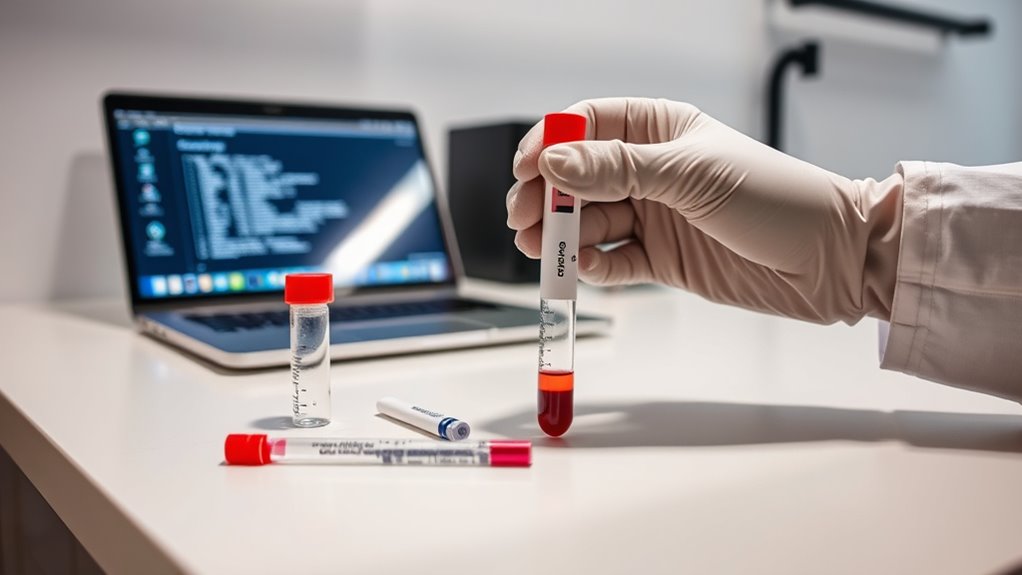
You need to guarantee your blood data stays private by using secure storage methods. Control who can access your information with strong confidentiality measures. Taking these steps helps protect your health details from unauthorized exposure.
Secure Data Storage
Securing your blood test data is essential to protect your privacy and prevent unauthorized access. Use data encryption to safeguard your information, ensuring it’s unreadable without a key. Set strict access permissions so only authorized devices or individuals can view or modify your data. Regularly update your security settings to patch vulnerabilities. Consider storing your data on secure, encrypted cloud services or offline devices. Keep a record of access logs to monitor activity and detect suspicious attempts. Here’s a quick overview:
| Security Step | Description | Best Practice |
|---|---|---|
| Data encryption | Protects data from unauthorized access | Use strong encryption algorithms |
| Access permissions | Controls who can view or edit data | Limit permissions to essential users |
| Regular updates | Keeps security current | Install updates promptly |
| Monitoring | Detects suspicious activity | Review access logs regularly |
Confidential Access Controls
To maintain privacy and protect your blood test data from unauthorized access, implementing strict access controls is vital. You should limit who can view or modify your data, using strong authentication methods like passwords or two-factor authentication. Access controls ensure only authorized individuals can access sensitive information. Additionally, data encryption plays an essential role; encrypt your data both during transmission and storage to prevent interception or unauthorized reading. Regularly update your security protocols and review access permissions to prevent breaches. Using secure platforms that prioritize privacy helps maintain confidentiality. By combining robust access controls with data encryption, you create multiple layers of security, safeguarding your blood test data from unauthorized access and ensuring your privacy remains protected.
Frequently Asked Questions
Can DIY Blood Tests Replace Regular Medical Checkups?
You might think diy blood tests can replace regular medical checkups, but they shouldn’t. Home testing offers convenience, yet it lacks the all-encompassing medical oversight needed for accurate diagnosis and treatment. While useful for monitoring specific conditions, they can’t replace the thorough evaluations your healthcare provider provides. Always consult a professional for proper interpretation and follow-up, ensuring your health remains accurately assessed and well-managed.
How Accurate Are DIY Blood Test Results Compared to Lab Tests?
Think of DIY blood test results as a snapshot, not a full portrait. Their test accuracy varies, and result reliability can be inconsistent compared to lab tests. While some DIY kits offer decent insights, they often lack the precision of professional lab equipment. You should view these results as preliminary, not definitive, and always consult healthcare providers for confirmation, especially when making health decisions.
Are There Age or Health Condition Restrictions for DIY Testing Kits?
You might wonder if age restrictions or health considerations affect DIY blood testing kits. Generally, these kits are suitable for most adults, but they often have age restrictions for minors or specific health conditions. If you’re pregnant, managing chronic illnesses, or have other health concerns, it’s best to consult a healthcare professional before using DIY testing kits. Always read the instructions carefully to guarantee safety and accuracy based on your age and health status.
What Are Common Errors That Can Invalidate My Blood Test Results?
You should be aware that common errors like sample contamination and improper sample collection can invalidate your blood test results. If you don’t clean your hands properly or mishandle the sample, it could skew the results. Make sure to follow the instructions carefully, avoiding touching the sample area or contaminating it with foreign substances. Accurate collection is key to reliable results and proper interpretation.
How Should I Store DIY Blood Testing Kits Between Uses?
To guarantee accurate results, you should follow proper storage tips for your DIY blood testing kits. Keep the kit in a cool, dry place away from direct sunlight, heat, and moisture. Always reseal any containers tightly and store the components separately if recommended. This maintains kit safety and integrity, preventing contamination or degradation. Proper storage helps ensure your test results remain reliable and accurate for future use.
Conclusion
By following best practices and understanding the limits of DIY blood testing, you can navigate your health journey with confidence. Remember, these tools are like gentle guides, offering insights without replacing professional care. Trust your instincts, stay informed, and know when to seek expert advice. With mindful attention and a cautious approach, you’ll keep your health story moving smoothly, turning small steps into meaningful progress along your wellness path.
